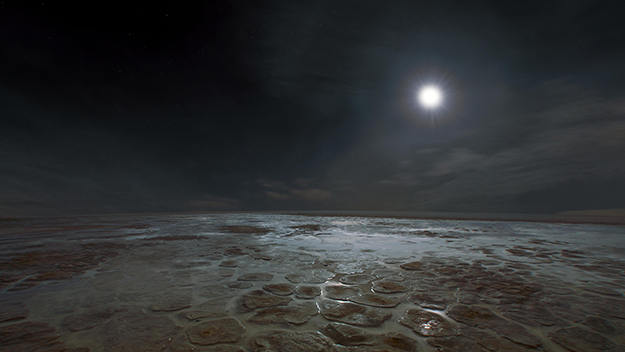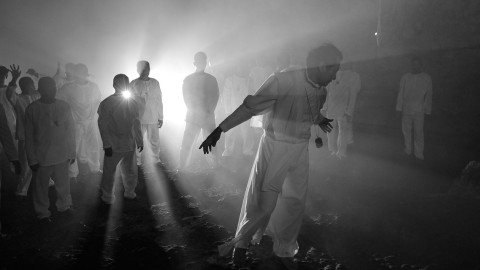Festivals: Venice

The Woman Who Left
Venice ’16 ended with something akin to a miracle: Lav Diaz’s The Woman Who Left was honored with the Golden Lion—which left even those burning brightly for the cause of Philippine cinema’s finest and bravest suddenly speechless with awe and joy. That Diaz wouldn’t leave the Lido empty-handed was fairly clear early on: around mid-festival, word spread that The Woman Who Left had two ardent supporters—good enough normally for an official recognition of some kind. One also heard a lot of rumors about the jury’s general dissatisfaction with the selection they had to judge, which is curious considering that the Best Director Award was bestowed ex aequo—to Amat Escalante for The Untamed and Andrei Konchalovsky for Paradise—suggesting an abundance of directorial excellence.
The Silver Lion Grand Jury Prize went to Tom Ford for Nocturnal Animals, which would have also made a most agreeable Golden Lion awardee, as far as best possible compromises go. (The other competition entry this could be said about—A Woman’s Life, Stéphane Brizé’s unexpectedly moving Maupassant adaptation and smart caméra-stylo exercise—went home from Venice without an award.) Ford’s sophomore effort, a sardonic essay on the patron class’s obsession with poor-white-trash gothic, is a heady, disturbing, sometimes unpleasant affair. It’s an unsparing watch that is rendered both an intellectual and a sensual delight by its directorial refinement and tact.
As for the rest: Emma Stone won the Best Actress Coppa Volpi for her part in the festival’s opening night pleasantry, Damien Chazelle’s La La Land, one of too many so-what entries from the U.S. and U.K. Two more awards went in that direction: Noah Oppenheim was handed the Best Screenplay Award for Pablo Larraín’s Jackie—another piece of cinéma de qualité; while Ana Lily Amirpour ended up with a Special Jury Prize for her poor attempt at a ’tude-boosted post-apocalypse actioner, The Bad Batch. The jury didn’t do much better with the two remaining awards: the Best Actor Coppa Volpi honored the best part about Mariano Cohn & Gastón Duprat’s The Distinguished Citizen (El Ciudadano Ilustre), namely Oscar Martínez in the lead role; while the Marcello Mastroianni Award for Best Young Actress highlighted one of several problems in François Ozon’s Frantz, Paula Beer, and rendered the formidable Judith Chemla—the heart, soul, and center of A Woman’s Life—the award night’s biggest loser.

A Woman’s Life
Despite too many mediocre entries, and a few truly nasty ones, the Competition not only fared far better than expected, but also proved more adventurous and daring than Orizzonti, the festival’s sidebar for the more “advanced” stuff. Not that the Competition jury offered laurels to masterpieces like Wim Wenders’s The Beautiful Days of Aranjuez and Terrence Malick’s Voyage of Time: Life’s Journey. But at least they were positioned in the festival’s spotlight where the mainstream journals and dailies had to deal with them. And didn’t at least The Woman Who Left and The Untamed get more attention than the voices of reason cared to predict? The best Orizzonti could come up with in terms of a cinema that is somewhat different were Venice regular Wang Bing’s slightly tired look at the plight of migrant workers, Bitter Money, honored by the Orizzonti jury to everybody’s puzzled amazement with a Best Screenplay Award; and Bill Morrison’s Dawson City: Frozen Time. This is, of course, nothing new: already in the later stages of Marco Müller’s reign, Orizzonti had deteriorated into a dump for “smaller” or slightly “offbeat” art-house productions.
The section’s lone masterpiece was Big Big World, Reha Erdem’s dreamy tale of an escape from lives oppressive into a forest full of wonder and menace, winner of the Special Jury Prize. In actor-turned-director Raúl Arévalo’s debut feature The Fury of a Patient Man, the mesmerizing Ruth Díaz was rewarded for her excellent performance as a pawn (to be sacrificed) in a sinister game of revenge. A debatable if finally dissatisfying work, Federica Di Giacomo’s Libera Nox (Liberami), won the Award for Best Film, while Fien Troch’s Home (Best Director) and Marco Martins’ São Jorge (Best Actor Award for Nuno Lopes) suggested the section’s general line: look a bit edgy, but please don’t disturb.
The great film that missed out on an award in this section was Gastón Solnicki’s Bela Bartók–driven, mightily minimalist, and drop-dead gorgeous Kékszakállú. It’s an eerie high-modernist fable of girls from a seemingly well-protected environment exiting their childhood castles for the wide world where pleasures lure and dangers lurk—and sometimes, merely a job needs to be found. Irony is the name of the game, but also a will for beauty that is extremely tactile, sensual, loosely woven—in that respect, at least, close to Bartók’s opera.

Kékszakállú
It is befitting that the main awards of both Competition and Orizzonti went to films with a deeply religious core, for Venice ’16 felt like one big seminar on spirituality. There were presentations of David Hansen’s Jesus VR – The Story of Christ, a virtual reality-project putting you right into the center of a painfully quaint passion play that looks as if it was put on by merry hick. One already fears the not-too-far future when the simpler souls of parishes are taught the Good Book’s more basic readings by way of this trashy 21st-century equivalent of medieval stained glass storytelling.
But this year’s biggest surprise was The Beautiful Days of Aranjuez, Wim Wenders’s greatest film since his very first feature, Summer in the City, in 1970. Even died-in-the-wool Wenders-ites were stunned by this deeply religious work of lush sensuality and stark, almost Straubian power. In some ways, Peter Handke is the film’s co-auteur: a good part of what makes The Beautiful Days of Aranjuez so stunning is his eponymous theater piece which Wenders treats with the utmost respect, going so far as to shoot it in French as this is the work’s original language. In addition, the main actress is Handke’s companion and probably the body and voice for which this role was written, while her male counterpart is cast and dressed in such a fashion as to resemble Handke but also in certain moments Wenders, which is a nice reflection of the intriguing mirror games that have been going on in their collaborations since the still mind-blowing 1969 short 3 American LP’s. Handke himself, again, has a cameo as a gardener working on a hedge. In many ways, The Beautiful Days of Aranjuez feels tone- and texture-wise closer to Handke’s own movie masterpieces, The Left-Handed Woman and The Absence, than anything ever done by Wenders.
Wenders leaves Handke’s play more or less untouched, apparently seeing his role as that of an observer-interpreter. That’s how a third character enters the film: a writer is introduced who quietly resembles Wenders’ long-time alter ego, Rüdiger Vogler. And with this third character, a third dimension is broached: 3-D. Wenders, it seems, finally found a text befitting his will to experiment with this technique, for The Beautiful Days of Aranjuez is also a brilliant feat of 3-D which shows, in an unobtrusive, precise, and perfectly thought-through fashion, what can be done with this space, which feels so abstract and otherworldly, bestowing curious weightlessness on human presence. In the end, apocalypse threatens—but isn’t the world already empty in the beginning?

Gantz:O
Another film set in a never-space was Kawamura Yasushi’s animated manga adaptation Gantz:O. Here, some dead souls awake in a computer game-version of purgatory where the only way back to life (or onward to Nirvana) consists of killing yōkai galore. That sounds a bit corny and somewhat dumb, but the movie proved to be deeply engaging thanks to the splendid character design, finely wrought pacing, and a re-creation of downtown Ōsaka’s Dōtonbori area so lovely and detailed one is quite happy that the epic brawl never goes far enough down the canal to endanger the fantastic canned-good bars. Gantz:O, by the way, was this year’s second-biggest surprise at Venice, for everybody thought that it was merely a token entry to cover certain constituencies: hip animation plus Japan (a miserably misrepresented film nation these days whose multi-facetted glory the Western festival circus rarely even hints at).
Somewhat underwhelming, on the other hand, was Federica Di Giacomo’s Libera Nox, a documentary about a Sicilian parish priest’s work as an exorcist, and the people who believe to have been possessed by a demon. In principle, the Di Giacomo does an adequate vérité job that delivers a view of things that is balanced in exactly the way one would have expected. Some seem to feel possessed (or just play the possessed) to get attention; others act out psychological problems and illnesses more or less consciously; and then there are cases one can’t be too certain about—with the priest being aware of all these options and able to deal with them appropriately. If one were unkind, one could call Libera Nox a social-democratic mondo movie: some sideshow excitement, with lots of psychology. But a kinder take would be to consider it a comédie humaine that takes a parish as a micro version of mankind. Still, there’s something intellectually as well as emotionally lazy about Libera Nox: the film just tells you what you always expected, and keeps the absurd and disturbing safely out of sight.
Yet the festival’s biggest disappointment was Paradise, which Andrei Konchalovsky managed to sink in the last two minutes—just as he did with 2014’s The Postman’s White Nights. Paradise has three protagonists: a collaborationist French police officer (who’s the one quickly killed by la résistance); a Russian émigré lady in Paris who gets deported to a death camp for hiding Jewish children; and a well-bred Nazi officer sent by Himmler himself to weed out corruption in the concentration camp industry; between scenes, they all sit in the same white space and talk into a camera explaining their lives and deeds. While the film is dedicated to the Russian émigrés who saved Jewish children in France, Paradise’s main character is the Nazi who is presented in a very Russian manner: an elegant, intelligent, yet ruthless man who believes with all his heart in the sanctity and justness of his cause; a man who also at one point confesses his admiration for Stalin and Communism. Politically speaking, this is all rather disagreeable if not outright despicable.

Hacksaw Ridge
Hacksaw Ridge became another major surprise of this year’s festival. Mel Gibson’s mix of Americana melodrama, WWII combat epic, and Christian allegory was a film of which few expected more than red-carpet fodder and maybe some ideologically demented moments. The true story of a conscientious objector who refused to wear arms but wanted to serve in combat as a medic (Desmond Doss) sounded too outrageous to not provoke the most irritating side of the man who gave us a Bible blockbuster in The Passion of the Christ and contemporary cinema’s most gruesome chase actioner, Apocalypto—works which both show a truly inspired auteur letting loose some of his worst innermost drives. Gibson must have done some soul-searching, for there’s ideologically little fundamentally wrong with Hacksaw Ridge. And aside the many shots of battle carnage and mayhem that have an infernal splendor, the film delivers in its two most eye-popping moments something akin to Gibson’s vision of Christianity: 1) an almost abstract shot of a machine gun’s breech from right atop, held by an attacking soldier, the breech fixed in the middle of the frame, with the corpse-littered ground floating by like a minced meat ocean, i.e., God’s view of things, His impassionate stare on the savagery of His creations, impartial and unmoving, self-composed and calm; 2) a shot of Doss on a stretcher hanging at an aerial lift, with the camera lowering itself to such a point that the sun seems to surround the stretcher like a halo—signifying that it is human beings who’re looking for something higher, greater, exemplary. That’s an idiosyncratic way of understanding Christianity—not helpful, perhaps, but hopeful in its awkward fashion.
Stridently more along the lines of the New Testament is Lav Diaz’s Tolstoy-inspired The Woman Who Left. Diaz’s story is of revenge finally rejected, and of forgiveness, but also of the evil one can set free by pondering deeds darkly even if in the end one refrains from committing them. After 30 years in prison, a woman is told by an inmate who over the decades became a close friend, that in fact she committed the murder for which she was condemned. She knows who’s really to blame: her then-boyfriend, a high-class criminal who framed her. After her release she starts to stake out his well-guarded house set smack in a slum. She meets new people there, starts a little business, provides some of her fellow human beings with a job, others with a new purpose in life; she grows especially close to a suicidal transvestite.
All this unfolds in images and sounds that are crystal clear, sharp, stupendous and tremendous in their unadorned simplicity—generous and caring like little else recently. And even if The Woman Who Left functions perfectly as a meditation on the nature of Goodness in a world of deceit and corruption, there’s also an important current affairs aspect to it. For what has been the reign of the Philippines’ latest president, Rodrigo Duterte, than a gigantic spree of vengeance killings? True, Diaz was shooting the film already before Duterte got elected but he certainly knew what was coming. There was absolutely nothing else in Venice that with similar ease and elegance, determination and grace fusing urgent politics with deep spiritual searching.

Voyage of Time: Life’s Journey Malick
Terrence Malick’s experimental natural science essay, Voyage of Time: Life’s Journey, offers thorny yet challenging questions of religions galore in an ultra-condensed fashion. Call it Inside The Tree of Life. The film delivers some perspective on the human drama in all its divine vastness, ranging from sweeping shots of meadows to animated dinosaurs dying on a beach. Wildlife footage is mixed with micro- and macroscopic photography plus some animation, all woven into a texture-wise seamless whole and held together by a voiceover (a female voice in Voyage of Time, Cate Blanchett; a male one, Brad Pitt, in The Imax Experience). Humans appear only occasionally—early on in very pixely-grainy shots of people suffering, later in scenes of Aborigine-like early inhabitants of planet earth at play, hunting and fighting (shot decades ago, like Tree of Life’s surrealist desert scenes, for what was then a project called Q). This is Malick at his most naked and raw—engrossing while tangled and entangling, brainy while deeply moving, if one allows oneself to engage with the experience. For that’s what it is, maybe more than any other Malick film so far: a purely cinematographic pleasure that addresses mind and soul alike.
What are the remains of a Nazi concentration camp when open to the public? Is it a sacred ground of suffering akin to a church? Is it a memorial-museum or a museum-memorial? How do we behave when we visit a space where we know some seven decades ago hundreds of thousands suffered or where even murdered, both systematically? Answers to that are demanded by Sergei Loznitsa’s Austerlitz, which shows the behavior of tourists on such a site. Folks are ordinarily dressed. It’s summer, and hot, so people wear as little as decency allows—but is Western European urban casual decent enough for a visit to the site of a former concentration camp? Why not, if people tend to dress casually even in church? Time and again one comes back to the question: are concentration camps churches of a secular religion? The religion is called memory—a religion much fought over on those sites, for not every memory is welcomed; one guide in particular gets lost in an anti-GDR-rant opining that the evil communist state abused the memory of the victims for its cause.
We get to hear several guides in different languages; in the usual Loznitsa way of creating abstraction, the focus comes via the sound design. What we see is unsurprising: people look briefly at execution grounds, gas chambers, and ovens, many take pictures, quite a few of them in front of execution grounds, gas chambers, and ovens. For them, this is a museum like any other, and by now, simply out of necessity, more or less all concentration camp memorial museum sites are sculpted and cleansed (in all meanings of the word), and made into something people can deal with easily and in an essentially preformatted fashion. In fact, it might be rewarding to discuss Austerlitz alongside works like Frederick Wiseman’s National Gallery or Johannes Rosenberger’s The Great Museum. Many in Venice thought that Loznitsa was judging the people drifting into and out of his long, fixed frames—but what would they have wanted him to do except not look at it, or inform everybody so that they could behave more “appropriately”?

Austerlitz
For Loznitsa, following the spirit of W.G. Sebald’s eponymous novel, Austerlitz, is above all about time’s work—how it erodes everything. It is, by the way, quite interesting to compare Sebald’s semantics with those of Loznitsa here: how the very long takes are structured into subsets through the groups and individuals appearing in and leaving the frame again, and also how from these first very basic shots, the cinematographic language becomes ever more complex. Is that in reaction perhaps to how the viewer’s understanding of the places and its myriad meanings grows?
Seventy years ago, several Auschwitz survivors started work on what’s probably the first postwar fiction film on a Nazi death camp: Wanda Jakubowska’s The Last Stage (1947). Thirty-five years after that came Claude Lanzmann, still struggling with Shoah—a film whose aesthetics of empty, evocative spaces stems from a time when images had a different value, and were not everywhere around (and maybe inside) us. Now, another 35 years on, Loznitsa shows masses of people making images of museum-memorial spaces they fill with… themselves. There’s a moral here.
Olaf Möller is a Cologne-born and -based film critic, writer and curator.







